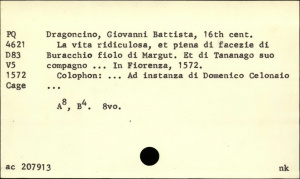Card catalogs
Card catalogs contain descriptions of a library's holdings on index cards. They remain important at the Folger Shakespeare Library, since not all items are described in Hamnet or in online finding aids. They also tell us something about what was important to scholars in the past. When you only have 3 x 5 inch cards, concision was paramount; they couldn't feasibly accommodate the lengthy descriptions and long lists of access points found in Folger online catalog records today. In addition, the physical wear on the cards (dirty tops, bent corners) can indicate which parts of the catalog were used most heavily.
Folger cards themselves are only available on site, but G.K. Hall & Co. published several printed editions of them (from photographs of the cards) in the 1970s and 1980s that can be found in libraries around the world (including the Folger).
What can only be found through Folger card catalogs
- Full records for Early modern Continental books acquired before 1997 that have not yet been fully cataloged online (for the most part, preliminary online records do exist)
- Full records for Eighteenth-century English books acquired before 1997 that have not yet been cataloged online (for the most part, preliminary online records do exist).
- Costumes
- Many playbills acquired before 1997, though collection-level records for them are now being added to Hamnet.
- Subject index to illustrations in pre-1604 English books at the Folger (see British book illustrations for online access to later illustrations; card file also includes many later STC and Wing illustrations)
See the List of card catalogs for all public card catalogs at the Folger.
Tips for using Folger card catalogs
- The card catalogs are no longer maintained (e.g., when the library acquires new playbills, they get described in Hamnet, not added to the card catalog for playbills)
- Alphabetizing conventions date to pre-computer days. Noteworthy differences include:
- Abbreviations file as if spelled out ("Dr." files as if spelled "Doctor")
- Numbers file as if spelled out ("5" files as if spelled "five", "5th" as if spelled "fifth", "3e" as if spelled "troisième", etc.)
- An article at the beginning of a title is ignored (same with online catalogs)
- Names beginning "Mc" and "Mac" are all filed as if spelled "Mac"
- Vowels with an umlaut are filed as if spelled with an added "e" (e.g. "Müller" files as if spelled "Mueller")
- "Nothing before something" – filing is word-by-word, not letter-by-letter. For example, "New York" files before "Newark" because the space after its "w" ("nothing") comes before the letter "a" after Newark's "w" ("something")
- "By before about" – all the works by a person file before books about the person, even though the heading on the card is the same (usually an inverted name plus birth and death dates)
- The call number is in the upper left
- The accession number or case file number will be recorded in the lower left, but may not be present for all items
- Some cards in the manuscript shelflist (located in the Cataloging Office) include numbers with an "M" prefix, written in pencil on the central part of the card. These are equivalent to the item's Film Fo. number, if the manuscript was microfilmed by the Folger at some point. (The corresponding microfilm may or may not be searchable in Hamnet.)
- Complete information is usually given only on the "main entry" card (the one filed under the first author's surname, or the title if the author is unknown) to avoid having to re-type everything on the cards for subjects, titles, additional authors, former owners, year of publication, etc.)
- Subject entries are sometimes typed in red (so that you call easily tell a card for a book by someone from a card for a book about that person.
- The carbon copies on thin, colored paper are "accession slips" – the preliminary records created in the Acquisitions department when something is first added to the collection. One gets filed under "main entry" (the author's name, unless the book is only known by its title) and the other gets filed in the "chron" file under year of publication. Presence of an accession slip indicates the book either remains uncataloged, or was cataloged after Hamnet came online in 1997.

